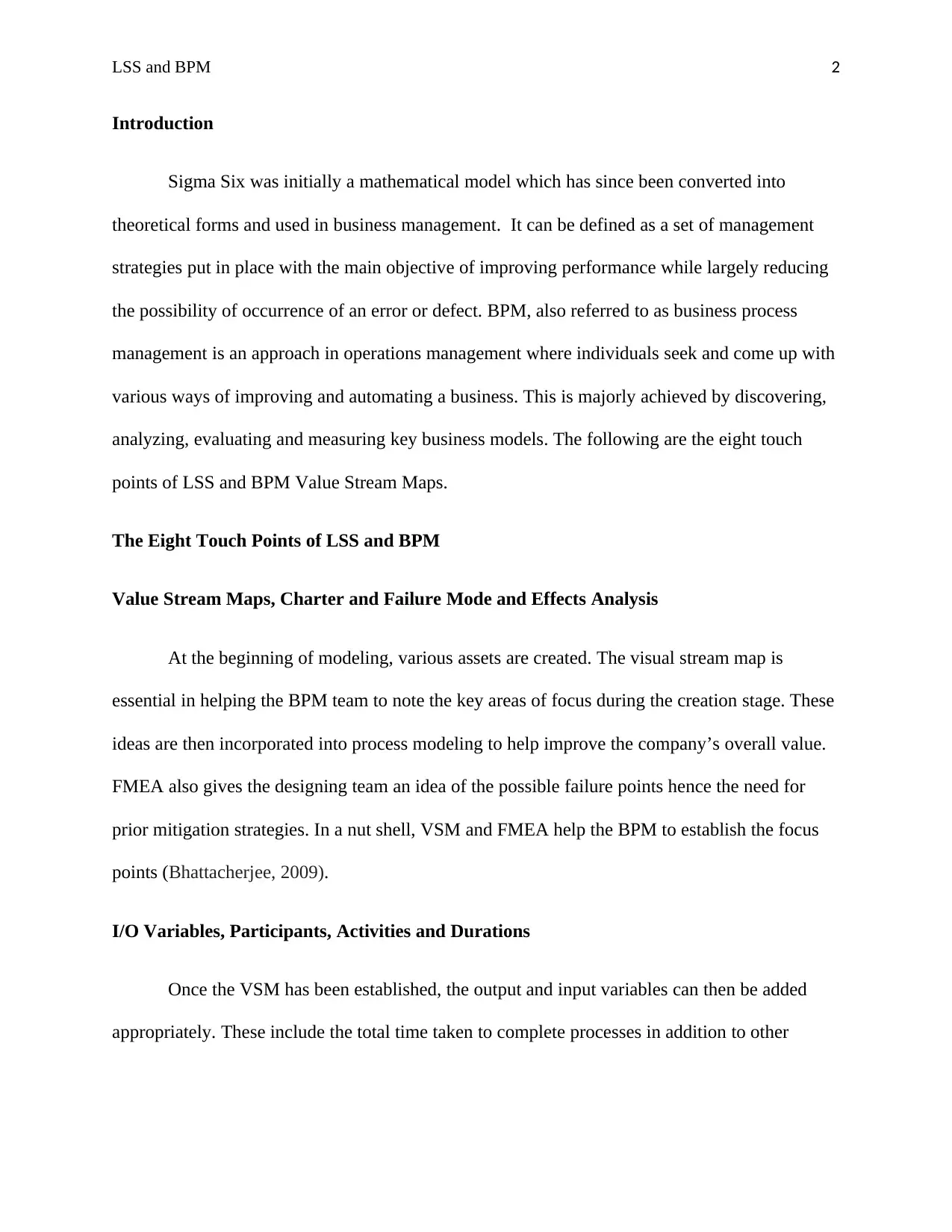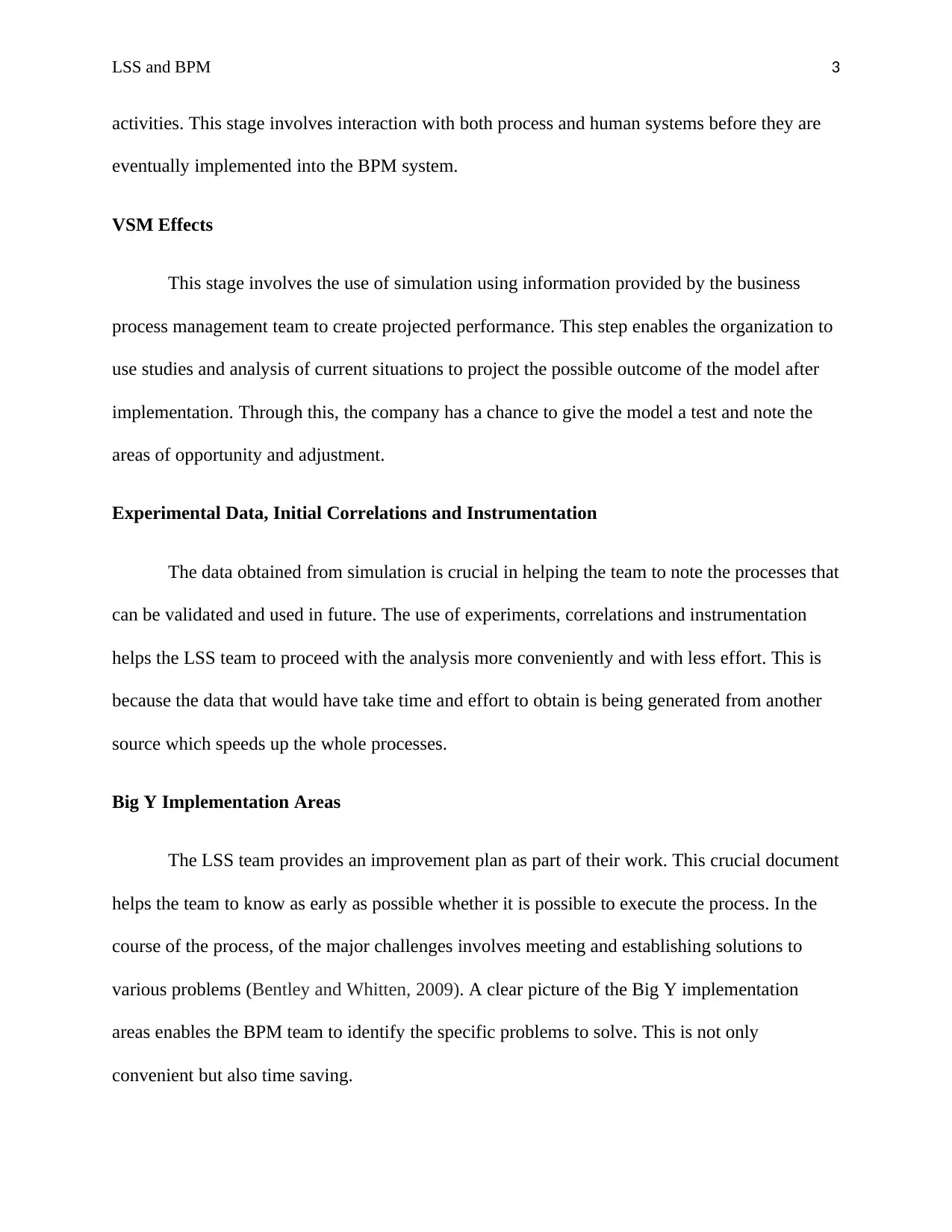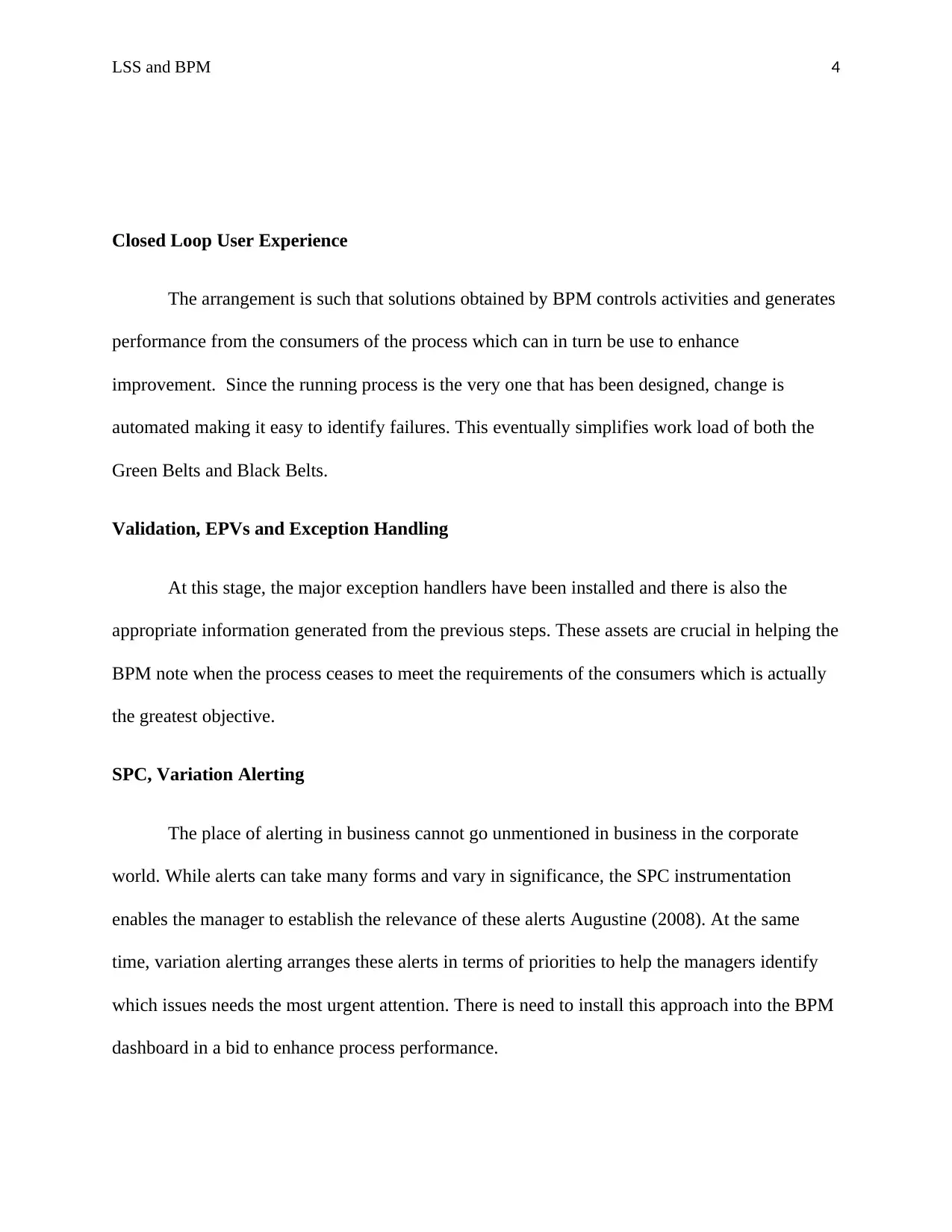The Eight Touch Points of LSS and BPM Value Stream Maps
VerifiedAdded on 2023/06/07
|5
|900
|180
AI Summary
This article discusses the eight touch points of LSS and BPM Value Stream Maps, including VSM and FMEA, I/O variables, participants, activities, and durations, VSM effects, experimental data, initial correlations, and instrumentation, Big Y implementation areas, closed loop user experience, validation, EPVs, and exception handling, and SPC and variation alerting. The article also includes references to relevant studies and articles.
Contribute Materials
Your contribution can guide someone’s learning journey. Share your
documents today.

Running Head: LSS and BPM 1
The Eight Touch Points of LSS and BPM Value Stream Maps
Name of Student
Name of Institution
Name of Course
Date of Submission
The Eight Touch Points of LSS and BPM Value Stream Maps
Name of Student
Name of Institution
Name of Course
Date of Submission
Secure Best Marks with AI Grader
Need help grading? Try our AI Grader for instant feedback on your assignments.

LSS and BPM 2
Introduction
Sigma Six was initially a mathematical model which has since been converted into
theoretical forms and used in business management. It can be defined as a set of management
strategies put in place with the main objective of improving performance while largely reducing
the possibility of occurrence of an error or defect. BPM, also referred to as business process
management is an approach in operations management where individuals seek and come up with
various ways of improving and automating a business. This is majorly achieved by discovering,
analyzing, evaluating and measuring key business models. The following are the eight touch
points of LSS and BPM Value Stream Maps.
The Eight Touch Points of LSS and BPM
Value Stream Maps, Charter and Failure Mode and Effects Analysis
At the beginning of modeling, various assets are created. The visual stream map is
essential in helping the BPM team to note the key areas of focus during the creation stage. These
ideas are then incorporated into process modeling to help improve the company’s overall value.
FMEA also gives the designing team an idea of the possible failure points hence the need for
prior mitigation strategies. In a nut shell, VSM and FMEA help the BPM to establish the focus
points (Bhattacherjee, 2009).
I/O Variables, Participants, Activities and Durations
Once the VSM has been established, the output and input variables can then be added
appropriately. These include the total time taken to complete processes in addition to other
Introduction
Sigma Six was initially a mathematical model which has since been converted into
theoretical forms and used in business management. It can be defined as a set of management
strategies put in place with the main objective of improving performance while largely reducing
the possibility of occurrence of an error or defect. BPM, also referred to as business process
management is an approach in operations management where individuals seek and come up with
various ways of improving and automating a business. This is majorly achieved by discovering,
analyzing, evaluating and measuring key business models. The following are the eight touch
points of LSS and BPM Value Stream Maps.
The Eight Touch Points of LSS and BPM
Value Stream Maps, Charter and Failure Mode and Effects Analysis
At the beginning of modeling, various assets are created. The visual stream map is
essential in helping the BPM team to note the key areas of focus during the creation stage. These
ideas are then incorporated into process modeling to help improve the company’s overall value.
FMEA also gives the designing team an idea of the possible failure points hence the need for
prior mitigation strategies. In a nut shell, VSM and FMEA help the BPM to establish the focus
points (Bhattacherjee, 2009).
I/O Variables, Participants, Activities and Durations
Once the VSM has been established, the output and input variables can then be added
appropriately. These include the total time taken to complete processes in addition to other

LSS and BPM 3
activities. This stage involves interaction with both process and human systems before they are
eventually implemented into the BPM system.
VSM Effects
This stage involves the use of simulation using information provided by the business
process management team to create projected performance. This step enables the organization to
use studies and analysis of current situations to project the possible outcome of the model after
implementation. Through this, the company has a chance to give the model a test and note the
areas of opportunity and adjustment.
Experimental Data, Initial Correlations and Instrumentation
The data obtained from simulation is crucial in helping the team to note the processes that
can be validated and used in future. The use of experiments, correlations and instrumentation
helps the LSS team to proceed with the analysis more conveniently and with less effort. This is
because the data that would have take time and effort to obtain is being generated from another
source which speeds up the whole processes.
Big Y Implementation Areas
The LSS team provides an improvement plan as part of their work. This crucial document
helps the team to know as early as possible whether it is possible to execute the process. In the
course of the process, of the major challenges involves meeting and establishing solutions to
various problems (Bentley and Whitten, 2009). A clear picture of the Big Y implementation
areas enables the BPM team to identify the specific problems to solve. This is not only
convenient but also time saving.
activities. This stage involves interaction with both process and human systems before they are
eventually implemented into the BPM system.
VSM Effects
This stage involves the use of simulation using information provided by the business
process management team to create projected performance. This step enables the organization to
use studies and analysis of current situations to project the possible outcome of the model after
implementation. Through this, the company has a chance to give the model a test and note the
areas of opportunity and adjustment.
Experimental Data, Initial Correlations and Instrumentation
The data obtained from simulation is crucial in helping the team to note the processes that
can be validated and used in future. The use of experiments, correlations and instrumentation
helps the LSS team to proceed with the analysis more conveniently and with less effort. This is
because the data that would have take time and effort to obtain is being generated from another
source which speeds up the whole processes.
Big Y Implementation Areas
The LSS team provides an improvement plan as part of their work. This crucial document
helps the team to know as early as possible whether it is possible to execute the process. In the
course of the process, of the major challenges involves meeting and establishing solutions to
various problems (Bentley and Whitten, 2009). A clear picture of the Big Y implementation
areas enables the BPM team to identify the specific problems to solve. This is not only
convenient but also time saving.

LSS and BPM 4
Closed Loop User Experience
The arrangement is such that solutions obtained by BPM controls activities and generates
performance from the consumers of the process which can in turn be use to enhance
improvement. Since the running process is the very one that has been designed, change is
automated making it easy to identify failures. This eventually simplifies work load of both the
Green Belts and Black Belts.
Validation, EPVs and Exception Handling
At this stage, the major exception handlers have been installed and there is also the
appropriate information generated from the previous steps. These assets are crucial in helping the
BPM note when the process ceases to meet the requirements of the consumers which is actually
the greatest objective.
SPC, Variation Alerting
The place of alerting in business cannot go unmentioned in business in the corporate
world. While alerts can take many forms and vary in significance, the SPC instrumentation
enables the manager to establish the relevance of these alerts Augustine (2008). At the same
time, variation alerting arranges these alerts in terms of priorities to help the managers identify
which issues needs the most urgent attention. There is need to install this approach into the BPM
dashboard in a bid to enhance process performance.
Closed Loop User Experience
The arrangement is such that solutions obtained by BPM controls activities and generates
performance from the consumers of the process which can in turn be use to enhance
improvement. Since the running process is the very one that has been designed, change is
automated making it easy to identify failures. This eventually simplifies work load of both the
Green Belts and Black Belts.
Validation, EPVs and Exception Handling
At this stage, the major exception handlers have been installed and there is also the
appropriate information generated from the previous steps. These assets are crucial in helping the
BPM note when the process ceases to meet the requirements of the consumers which is actually
the greatest objective.
SPC, Variation Alerting
The place of alerting in business cannot go unmentioned in business in the corporate
world. While alerts can take many forms and vary in significance, the SPC instrumentation
enables the manager to establish the relevance of these alerts Augustine (2008). At the same
time, variation alerting arranges these alerts in terms of priorities to help the managers identify
which issues needs the most urgent attention. There is need to install this approach into the BPM
dashboard in a bid to enhance process performance.
Secure Best Marks with AI Grader
Need help grading? Try our AI Grader for instant feedback on your assignments.

LSS and BPM 5
References
Augustine, N. (2008) ‘Reshaping an industry: lockheed martin’s survival story’, Harvard
Business Review (July-August).
Bentley, L. and Whitten, J. (2009). System Analysis & Design for the Global Enterprise. New
York: SAGE
Bhattacherjee, A. (2009) ‘The Impact of ERP Capability Implementation on Business Process
Outcomes: A Factor Based Study’, Journal of management Information Systems, 24(1),
p23.
References
Augustine, N. (2008) ‘Reshaping an industry: lockheed martin’s survival story’, Harvard
Business Review (July-August).
Bentley, L. and Whitten, J. (2009). System Analysis & Design for the Global Enterprise. New
York: SAGE
Bhattacherjee, A. (2009) ‘The Impact of ERP Capability Implementation on Business Process
Outcomes: A Factor Based Study’, Journal of management Information Systems, 24(1),
p23.
1 out of 5
Your All-in-One AI-Powered Toolkit for Academic Success.
+13062052269
info@desklib.com
Available 24*7 on WhatsApp / Email
![[object Object]](/_next/static/media/star-bottom.7253800d.svg)
Unlock your academic potential
© 2024 | Zucol Services PVT LTD | All rights reserved.
